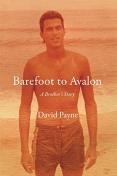BKMT READING GUIDES
Barefoot to Avalon: A Brother's Story
by David Payne
Hardcover : 304 pages
0 club reading this now
0 members have read this book
?A brave book with beautiful sentences on every page.”?New York Times
?Piercing...a tour de force.”?Los Angeles Times
In 2000, while moving his household from Vermont to North Carolina, David Payne watched from his ...
Introduction
?A brave book with beautiful sentences on every page.”?New York Times
?Piercing...a tour de force.”?Los Angeles Times
In 2000, while moving his household from Vermont to North Carolina, David Payne watched from his rearview mirror as his younger brother, George A., driving behind him in a two-man convoy of rental trucks, lost control of his vehicle, fishtailed, flipped over in the road, and died instantly. Soon thereafter, David’s life hit a downward spiral. His career came to a standstill, his marriage disintegrated, and his drinking went from a cocktail-hour indulgence to a full-blown addiction. He found himself haunted not only by George A.’s death, but also by his brother’s manic depression, a hereditary illness that overlaid a dark family history whose roots now gripped David.
Barefoot to Avalon is Payne’s earnest and unflinching account of George A. and their boyhood footrace that lasted long into their adulthood, defining their relationship and their lives. As universal as it is intimate, this is an exceptional memoir of brotherhood, of sibling rivalries and sibling love, and of the torments a family can hold silent and carry across generations.
Editorial Review
An Amazon Best Book of August 2015: Imagine Mary Karr’s best poetic prose superimposed on material reminiscent of Pat Conroy and you begin to get an idea of what you’re in for with Barefoot to Avalon, a deeply moving memoir of brotherly love and loss. Payne, a novelist, settles his story around the horrific death of his brother, George A., a death he witnessed from his rear view mirror as the two caravanned from Vermont to North Carolina. In this case, George A. – the initial is always used, in direct address as well as exposition, because it always was used in the Payne family; this is one of the many tiny details that marks the memoir as authentic and heartbreaking – had come north to help his big brother move. The norm, however, at least in the years immediately prior, was the other way around; David, while a struggling writer, usually took care of George A., whose long-undiagnosed mental illness had led him to lose friends, family, and a promising career. (But make no mistake: David was no angel and admits to envying George A. and competing with him every step of the way.) By looping back and forth in time – with more than a few chilling scenes of both brothers’ adolescent struggles with their alcoholic, violent father and denial-champion of a mother – Payne paints a portrait of dysfunction that is both sad and infuriating: George A’s death might have been an accident, but he’d been suffering so mightily for so long, it seemed predetermined. What happened to those boys as children – and how guilt- and grief-ridden David spins out of control once his brother is gone – will make every reader cringe, and many cry. – Sara Nelson
Discussion Questions
No discussion questions at this time.Book Club Recommendations
Recommended to book clubs by 0 of 0 members.
Book Club HQ to over 90,000+ book clubs and ready to welcome yours.
Get free weekly updates on top club picks, book giveaways, author events and more








